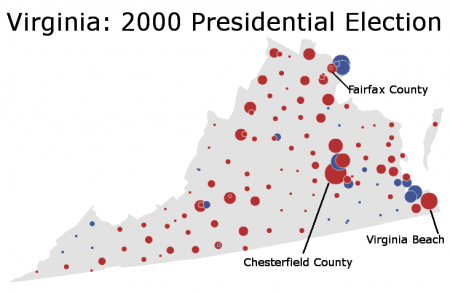This is the third part of a series of posts analyzing the swing state Virginia. It is the first section of two focusing on Northern Virginia. The fourth part can be found here.
NoVa
A vast and growing suburban metropolis, Northern Virginia has become increasingly important in Virginia politics. There, demographic changes have imperiled Republican dominance of Virginia.
To illustrate the exceptional nature of this movement, compare the two elections below. Here is 2000:
Eight years later, Northern Virginia has transformed:
More below.
In 2000, Governor George W. Bush had won Virginia by a comfortable 8.1% margin, carving out the traditional Republican coalition of rural and suburban Virginia. As this picture indicates, Virginia Democrats in 2000 really don’t have a base of support, except perhaps the heavily black southeast parts of the state. By 2008 Senator Barack Obama won the state by an equally comfortable 6.30% – a 14.3% shift in support.
Before digging into the dynamics of modern NoVa, it is worth exploring its past behavior to gain a sense of context.
A History
Northern Virginia was not always as populous as it is today; well into the twentieth century, it remained a rural (and heavily Democratic) backwater. In the 1940 presidential election, for instance, less than 10,000 people voted in Arlington County.
Growth began in the 1940s, however, driven by an ever-expanding federal government. The inner-ring suburbs in Arlington started expanding first, followed by Fairfax County in the 1950s. Like many other white and wealthy suburbs, Northern Virginia leaned Republican during this era.
Unlike some suburbs, however, Northern Virginia never fell in love with Republicanism. In Fairfax County, Republican presidential candidates only once took more than 65% of the vote (in 1972) – something which would regularly happen in a place like Chesterfield County, a suburb of Richmond.
Change first began in the 1980s, when inner-ring suburbs such as Arlington started voting Democratic. In the 2000 map, one sees Arlington County as the lonely blue bubble to the right of Fairfax County.
By 2000, as the graph above indicates, change was coming to the suburban communities in Fairfax. In 2004 the county voted Democratic by a 7.30% margin, which should have been a warning sign to Republicans. A mere two years later, it powered Democratic candidate Jim Webb to a narrow victory over incumbent Senator George Allen (he won the county by 18.9%). In 2008 Fairfax – well, just look at the map to see what happened in 2008.
In just eight short years, Northern Virginia has turned from a Republican-leaning suburb into a fundamental part of the Democratic base. Virginia has changed from a red state into a purple one, due mainly (but not entirely) to Northern Virginia.
The next post will explore Northern Virginia today – in order to get a sense of how this has happened.
–Inoljt, http://mypolitikal.com/



“In just eight short years, Northern Virginia has turned from a Republican-leaning suburb into a fundamental part of the Democratic base. Virginia has changed from a red state into a purple one, due mainly (but not entirely) to Northern Virginia.”
How can an eight year trend be construed as ‘fundamental’?